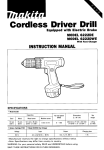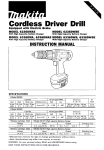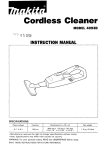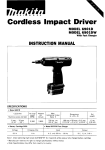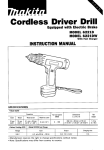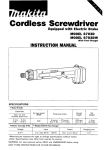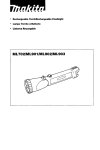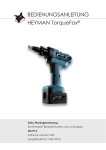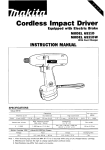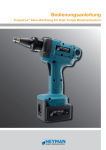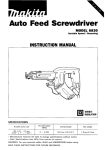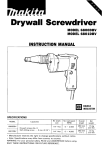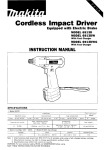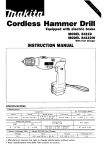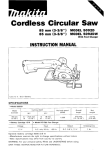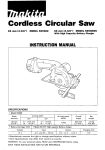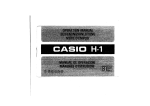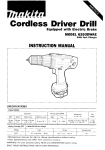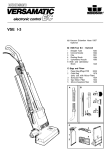Download Makita 6223DE Instruction manual
Transcript
Equipped with Electric Brake MODEL 6223DE MODEL 6223DWE With Fast Charger INSTRUCTION MANUAL SPECIFICAT10 NS Capacities Steel 10 mm (318") 9 Wood I 15 mm 1518") Wood screw I 5.1 mm x 35 mm 13/16" x 1-318") Battery Cartridge 1220 Dimensions IRPM) iL x W x HI Net weight I 6 m m 1114") 202 mm x 94 mm x 221 mm 17-15/16" x 3-11/16" x 8-3/4'1 1.5 kg (3.1 lbsl I ~ 700 1 Model DC1290 Fast Charger Voltage 12 v No load speed Machine screw Input 1 A.C. only 50 Hz - 60 Hz output 1 D.C.9.6 V, 12 V Charging time 1 * Manufacturer reserves the right t o change specifications without notice. * Note: Specifications may differ from country to country. WARNING: For your personal safety, READ and UNDERSTAND before using. SAVE THESE INSTRUCTIONS FOR FUTURE REFERENCE. 1 Hr. GENERAL SAFETY RULES (For All Battery Operated Tools) WARNING! Read and understand all instructions. Failure to follow all instructions listed below, may result in electric shock, fire and/or serious personal injury. SAVE THESE INSTRUCTIONS Work Area Keep your work area clean and well lit. Cluttered benches and dark areas invite accidents. Do n o t operate power tools in explosive atmospheres, such as in the presence of flammable liquids, gases, or dust. Power tools create sparks which may ignite the dust or fumes. Keep bystanders, children, and visitors away while operating a power tool. Distractions can cause you t o loose control. Electrical Safety A battery operated tool w i t h integral batteries or a separate battery pack must be recharged only w i t h the specified charger for the battery. A charger that may be suitable for one type of battery may create a risk of fire when used w i t h another battery. Use battery operated tool only w i t h specifically designated battery pack. Use of any other batteries may create a risk of fire. Personal Safety .Stay alert, watch w h a t you are doing, and use common sense when operating a power tool. Do not use tool while tired or under the influence of drugs, alcohol, or medication. A moment of inattention while operating power tools may result in serious personal injury. Dress properly. Do not wear loose clothing or jewelry. Contain long hair. Keep your hair, clothing, and gloves away from moving parts. Loose clothes, jewelry, or long hair can be caught in moving parts. Avoid accidental starting. Be sure s w i t c h is in the locked or o f f position before inserting battery pack. Carrying tools with your finger on the switch or inserting the battery pack into a tool with the switch on invites accidents. Remove adjusting keys or switches before turning the tool on. A wrench or a key that is left attached to a rotating part of the tool may result in personal injury. Do not overreach. Keep proper footing and balance at all times. Proper footing and balance enable better control of the tool in unexpected situations. Use safety equipment. Always wear eye protection. Dust mask, nonskid safety shoes, hard hat, or hearing protection must be used for appropriate conditions. Tool Use and Care Use clamps or other practical way t o secure and support the workpiece t o a stable platform. Holding the work by hand or against your body is unstable and may lead t o loss of control. Do not force tool. Use the correct tool for your application. The correct tool will do the job better and safer at the rate for which it is designed. * D o not use tool if s w i t c h does not turn it on or off. A tool that cannot be controlled with the switch is dangerous and must be repaired. -Disconnect battery pack from tool or place the switch in the locked or off position before making any adjustments, changing accessories, or storing the tool. Such preventive safety measures reduce the risk of starting the tool accidentally. Store idle tools out of reach of children and other untrained persons. Tools are dangerous in the hands of untrained users. When battery pack is n o t in use, keep it away from other metal objects like: paper clips, coins, keys, nails, screws, or other small metal objects that can make a connection from one terminal t o another. Shorting the battery terminals together may cause sparks, burns, or a fire. Maintain tools w i t h care. Keep cutting tools sharp and clean. Properly maintained tools with sharp cutting edge are less likely t o bind and are easier t o control. Check for misalignment or binding of moving parts, breakage of parts, and any other condition that may affect the tool's operation. I f damaged, have the tool serviced before using. Many accidents are caused by poorly maintained tools. Use only accessories that are recommended by the manufacturer for your model. Accessories that may be suitable for one tool may create a risk of injury when used o n another tool. Service Tool service must be performed only by qualified repair personnel. Service or maintenance performed by unqualified personnel may result in a risk of injury. When servicing a tool, use only identical replacement parts. Follow instructions i n the Maintenance section of this manual. Use of unauthorized parts or failure t o follow Maintenance Instructions may create a risk of shock of injury. 3 Specific Safety Rules 1. Hold tool by insulated gripping surfaces when performing an operation where the cutting tool may contact hidden wiring. Contact with a "live" wire will also make exposed metal parts of the tool "live" and shock the operator. 2. Be aware that this tool is always in an operating condition, because it does not have t o be plugged into an electrical outlet. 3.Always be sure you have a firm footing. Be sure no one is below when using the tool in high locations. 4. Hold the tool firmly. 5. Keep hands away from rotating parts. 6. Do not leave the tool running. Operate the tool only when hand-held. 7. Do not touch the drill bit or the workpiece immediately after operation; they may be extremely hot and could burn your skin. 4 SYMBOLS The followings show the symbols used for tool ................................. volts ............... amperes ................................. herts ................ kilograms ................................. hours ................... minutes ............ seconds ................................. alternating current _._. direct current ................................. no load speed ................................. alternating or direct current ................................. Class II Construction ................................. splash-proof construction ................................. watertight construction ................................ revolutions or reciprocation per minute ................................. number of blow 5 IMPORTANT SAFETY INSTRUCTIONS FOR CHARGER & BATTERY CARTRlDGE I. SAVE THESE INSTRUCTIONS - This manual Length of Cord (Feet) AWG Size of Cord 25 18 50 18 100 18 150 16 9. Do not operate charger w i t h damaged cord or plug - replace them immediately. IO. Do not operate charger if it has received a sharp blow, been dropped, or other- wise damaged in any way; take it t o a qualified serviceman. 1 1 . Do not disassemble charger or battery cartridge; take it t o a qualified serviceman when service or repair is required. Incorrect reassembly may result in a risk of electric shock or fire. 12.To reduce risk of electric shock, unplug charger from outlet before attempting any maintenance or cleaning. Turning off controls will not reduce this risk. 6 ADDITIONAL SAFETY RULES FOR CHARGER & BATTERY CARTRIDGE 1. Do n o t charge Battery Cartridge when temperature is BELOW 10°C (5OOF) or ABOVE 4OoC (104OF). 2. Do not attempt t o use a step-up transformer, an engine generator or DC power receptacle. 3.Do n o t allow anything t o cover or clog the charger vents. 4. Always cover the battery terminals w i t h the battery cover w h e n the battery cartridge is n o t used. 5. A battery short can cause a large current flow, overheating, possible burns and even a breakdown. (1) Do n o t touch the terminals with any conductive material. (2) Avoid storing battery cartridge in a container with other metal objects such as nails, coins, etc. (3)Do n o t expose battery cartridge t o water or rain. 6. Do n o t store the tool and Battery Cartridge in locations where the temperature may reach or exceed 5OoC (122OF). 7. Do not incinerate the Battery Cartridge even if it is severely damaged or is completely worn out. The battery cartridge can explode in a fire. SAVE THESE INSTRUCTIONS. 7 Installing or removing battery cartridge *Always switch off the tool before insertion or removal of the battery cartridge *To remove the battery cartridge, withdraw it from the tool while pressing the buttons on both sides of the cartridge. *To insert the battery cartridge, align the tongue on the battery cartridge with the groove in the housing and slip it into place. Always insert it all the way until it locks in place with a little click. If not, it may accidentally fall out of the tool, causing injury to you or someone around you. *Do not use force when inserting the battery cartridge. If the cartridge does not slide in easily, it is not being inserted correctly. Charging Plug the fast charger into your power source. Insert the battery cartridge so that the plus and minus terminals on the battery cartridge are on the same sides as their respective markings on the fast charger. Insert the cartridge fully into the port so that it resets on the charger port floor. The charging light will come on and charging will begin. If the charging light goes out soon, remove the battery cartridge from the charger and let it cool off for more than one minute, Then re-insert it and try to charge it once more. If the charging light goes out within one minute even after repeating this procedure a couple of times, the battery cartridge is dead. Replace it with a new one. When the charging light goes out after about one hour, you may remove the fully charged battery cartridge. After charging, unplug the charger from the power source. CAUTION: *Your new battery cartridge is not charged. You will need to charge it before use. *If you try to charge a cartridge from a just-operated tool, sometimes the charging light will not come on. If this occurs, let the cartridge cool off for a while. Then re-insert it and try to charge it once more. *When you charge a new battery cartridge or a battery cartridge which has not been used for a long period, it may not accept a full charge. This is a normal condition and does not indicate a problem. You can recharge the battery cartridge fully after discharging it almost completely a couple of times. *If you wish to charge two battery cartridges, allow 15 minutes between chargings on the fast charger. 8 ASSEMBLY Installing or removing driver bit or drill bit CAUTlON : Always be sure that the tool is switched off and the battery cartridge is removed before installing or removing the bit. Hold the ring and turn the sleeve counterclockwise to open the chuck jaws. Place the bit in the chuck as far as it will go. Hold the ring firmly and turn the sleeve clockwise to tighten the chuck. To remove the bit, hold the ring and turn the sleeve counterclockwise. OPERATION Switch action Tool speed is increased by increasing pressure on the trigger. To start the tool, simply pull the trigger. Release the trigger to stop. CAUTION: Before inserting the battery cartridge into the tool, always check to see that the switch trigger actuates properly and returns to the “OFF” position when released. Reversing switch action This tool has a reversing switch to change the direction of rotation Slide the reversing switch to the left for clockwise rotation or to the right for counterclockwise CAUTION *Always check the direction of rotation before operation *Move the reversing switch only after the tool comes to a complete stop Changing the direction of rotation before the tool stops may damage the tool 9 CAUTION: Always withdraw the tool from the workpiece before resuming operation. If the tool cannot be withdrawn, hold the tool firmly when turning on the tool, to overcome a strong reaction Adjusting the fastening torque The fastening torque can be adjusted in six stages by turning the adjusting ring so that the pointer on the adjusting ring points to a number on the tool body. The fastening torque is minimum when the pointer points to the number 1 and maximum when it points to the at- marking. The clutch will slip a t varying torque levels when the pointer is set at the numbers 1 to 5. The clutch marking. is designed not to slip a t the ax- Pointer - , ,- - - I Drill marking I I1 your material or a piece of duplicate mate for a particular application. The adjusting ring cannot be locked with the pointer positioned half-way between the numbers. Installing set plate Always install the set plate when using battery cartridges 1200, 1202 or 1202A. Install the set plate on the tool with the screw provided. Screw Set plate Screwdriving operation Place the point of the driver bit in the screw head and apply pressure to the tool. Start the tool slowly and then increase the speed gradually. Release the trigger as soon as the clutch cuts in. _ 10 _ ~ NOTE: *Make sure that the driver bit is inserted straight in the screw head, or the screw and/or bit may be damaged *When driving wood Screws, predrill pilot holes to make driving easier and to prevent splitting of the workpiece. See the chart. 4 8 (3116") 5 1 (13164") I I 3 1 33 - 3 4 (118'' - 9/64',) 3 6 (118'' - 9/64',) Drilling operation First, turn the adjusting ring so that the pointer on the adjusting ring points to the *\- marking. Then proceed as follows. *Drilling in wood When drilling in wood, best results are obtained with wood drills equipped with a guide screw. The guide screw makes drilling easier by pulling the bit into the workpiece. *Drilling in metal To prevent the bit from slipping when starting a hole, make an indentation with a centerpunch and hammer at the point to be drilled. Place the point of the bit in the indentation and start drilling. Use a cutting lubricant when drilling metals. The exceptions are iron and brass which should be drilled dry. CAUTION: *Pressing excessively on the tool will not speed up the drilling. In fact, this excessive pressure will only serve to damage the tip of your bit, decrease the tool performance and shorten the service life of the tool. *There is a tremendous force exerted on the tool/bit a t the time of hole breakthrough. Hold the tool firmly and exert care when the bit begins to break through the workpiece. *A stuck bit can be removed simply by setting the reversing switch to reverse rotation in order to back out. However, the tool may back out abruptly if you do not hold it firmly. *Always secure small workpieces in a vise or similar hold-down device 11 MAINTENANCE CAUTlON : Always be sure that the tool is switched off and the battery cartridge is removed before attempting t o perform inspection or maintenance. To maintain product SAFETY and RELIABILITY, repairs, maintenance or adjustment should be performed by Makita Authorized or Factory Service Centers, always using Makita replacement parts. Recycling the Battery The only way to dispose of a Makita battery is to recycle it. The law prohibits any other method of disposal. I Ni-Cd To recycle the battery: 1. Remove the battery from the tool. 2. a). Take the battery to your nearest Makita Factory Service Center or b). Take the battery to your nearest Makita Authorized Service Center or Distributor that has been designated as a Makita battery recycling location. Call your nearest Makita Service Center or Distributor to determine the location that provides Makita battery recycling. See your local Yellow Pages under "Tools-Electric' : 12 ACCESSORIES CAUTION: These accessories or attachments are recommended for use w i t h your Makita tool specified in this manual. The use of any other accessories or attachments might present a risk of injury t o persons. The accessories or attachments should be used only in the proper and intended manner. Bits Drill bits Size Part No. Phillips - Slotted I # 5F #7F I 7 8 4 0 1 0-OA 784011-0A I 711011-A 711012-A 711013-A Phillips bit NO. I Size 7 8 4 2 0 1- 5 784202-3 784203-1 Drill dia. Part No, I Part Tested best in Makita driver-drills for s m o o t h fast drilling and more holes per b a t t e r y change. H i g h speed steel. For drilling in metal, w o o d and plastic. Jobbers length. Special surface t r e a t m e n t for lubricity gives smoother drilling. I L (mm) 6 5 (2-518") 4 5 (1-314") 6 5 (2-518") 784206-5 1 1 0 (4.318") 784207-3 1 5 0 (5-718") 1 1116" 3132" 711014-A 118" 5/32" 711015-A 711016-A 3/16" 7/32" Shank dia. I 1116" 3/32" 118" 5/32" 3116" 7/32" Flute length 1 718" 1-114" 1-518'' 2" Overall length 1 1-718" 2 114" 2-314" 3.118" 71 101 7-A 114" 114" 2-5/16'' 2-112" 2-314" 3-112" 3-314" 41" 711018-A 9/32" 5/16" 2-5/16" 3-3/16'' 4.114" 711019-A 9132" 5116" 71 1020-A 11/32" 11132" 3-711 6" 4-314" 711021-A 318" 318" 3-518" 5" 4-112" 7 1 1000-A-A Rubber pad assembly Wool bonnet Part No. 1 2 3 0 0 1 - 2 Part No. 7 4 3 4 0 1 - 6 Foam polishing pad 1 Hour charger Part No. 7 4 3 0 2 3 - 2 Model DC1290 Part No. 1 1 3 1 1 9 - 7 13 High Capacity charger Model DC1201 Part No. 113126.0 High Capacity charger Model DC1411 Battery cartridge 1220 Part No. 632804-8 Automotive High Capacity Charger Model DC1412 Plastic carrying case Part No. 824510-1 Battery cover Part No. 414938-7 14 Jan -08-'98 US CORDLESS DRIVER DRILL Model 6223D Note: The s w i t c h and other part configurations may differ from c o u n t r y t o country. 15 Jan -08-’98 MODEL 6 2 2 3 D ITEM $& ITEM DESCRIPTION NO. NO. USED US DESCRIPTION MACHINE ~ 1 2 3 4 5 6 7 8 9 10 11 12 13 14 15 16 17 18 1 6 1 1 1 2 2 1 19 20 1 Housing Set [With Item 381 Name Plate Tapping Screw 4 x 1 8 Pan Head S c r ~ wM 4 x 2 2 Switch Lever Battery Holder Swifch Lever Compression Spring 27 Compression Spring 22 Washer I O Thrust Needle Gauge 1 0 2 3 Flat Washer 1 0 Slider Cam Plate Pan Hodd Screw M 3 x 1 4 Change Ring Stop Ring E 9 Ball Bearing 6000LLB Bearin“ Retainer 1 4 21 22 23 24 25 26 27 28 29 30 31 32 33 34 35 36 37 38 39 40 1 1 1 Spindle Keyless Orill Chuck 1 0 Pan Head Screw M 5 x 2 2 Clutch Cam Clutch Cam Complete Ball Bearing 6805LLB 1 1 1 1 1 1 1 Sput Gear 1 5 Spur Gear 1 5 Spur Gear 1 5 Spur Gear 9 Complete Spur Gear 1 5 Spur Gear 1 5 Spur Gear 1 5 Internal Gear 4 2 Flat Washer 1 2 OC Motor Steel Ball 5 6 Housing Set lWifh Item 11 Makita Label Balterv 1 2 2 0 1 1 1 1 1 1 3 1 1 1 Note The s w m h and other p a r i specifications may differ f r o m country t o c o u n t v MAKITA LIMITED ONE YEAR WARRANTY Warranty Policy Every Makita tool is thoroughly inspected and tested before leaving the factory. It is warranted t o be free of defects from workmanship and materials for the period of ONE YEAR from the date of original purchase. Should any trouble develop during this one-year period, return the COMPLETE tool, freight prepaid, t o one of Makita’s Factory or Authorized Service Centers. If inspection shows the trouble is caused by defective workmanship or material, Makita will repair (or at our option, replace) without charge. This Warranty does not apply where: repairs have been made or attempted by others: repairs are required because of normal wear and tear: The tool has been abused, misused or improperly maintained; alterations have been made to the tool IN NO EVENT SHALL MAKITA BE LIABLE FOR ANY INDIRECT, INCIDENTAL OR CONSEQUENTIAL DAMAGES FROM THE SALE OR USE O F THE PRODUCT. THIS DISCLAIMER APPLIES BOTH DURING AND AFTER THE TERM O F THIS WARRANTY. MAKITA DISCLAIMS LIABILITY FOR ANY IMPLIED WARRANTIES, INCLUDING IMPLIED WARRANTIES O F “MERCHANTABILITY” AND “FITNESS FOR A SPECIFIC PURPOSE.’’ AFTER THE ONE-YEAR TERM OF THIS WARRANTY. This Warranty gives you specific legal rights, and you may also have other rights which vary from state to state. Some states do not allow the exclusion or limitation of incidental or consequential damages, so the above limitation or exclusion may not apply t o you. Some states do not allow limitation on how long an implied warranty lasts, so the above limitation may not apply t o you. - ___) L_ Makita (China) Co., Ltd. HUANGPU JlANG ROAD, KUNSHAN ECONOMIC & TECHNICAL DEVELOPMENT ZONE, JIANGSU PR. CHINA 884130 - 065 PRINTED IN JAPAN 1998-1 - N
















